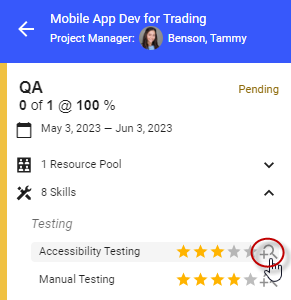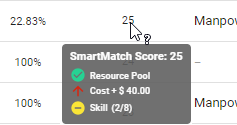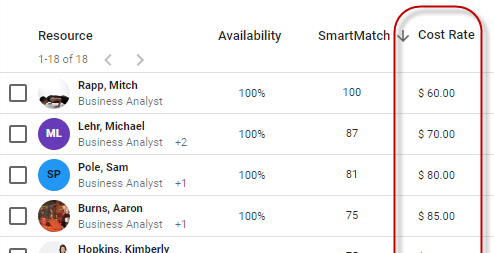Fulfilling resource requests
As a resource manager, it’s your job to allocate specific resources to projects. You’ll aim to meet, as closely as possible, the requirements defined in resource requests submitted by project managers.
Refer to All about resourcing for more information.
Resource managers can’t fulfill resource requests using Replicon Mobile. However, they can manage resource profiles.
To see details of resource requests submitted, alongside details of the actual allocation made, use the Resource Request vs Allocation report template.
Allocating resources
You will receive a notification when a resource request has been submitted by a project manager.
To allocate resources:
- Click Project Resourcing > Pending.
Unfulfilled requests display here, in Pending state. Each project has its own section; click theicon to expand a section, if needed.
- Click + Assign Resource.
- Select resources and allocations that match request criteria.
If the resource you select has availability conflicts with the proposed allocation, a dialog showing SmartFit options will display. Refer to Handling availability limitations when allocating resources to a project for more information about these options.
- Once you’ve selected resources, click the
icon to propose the selected resources.
The request’s status will update to Proposed, and the request will move to the Proposed tab. Your suggestions will be sent to the project manager, and they will be notified that their request has been fulfilled.
The project manager can:
-
- Accept the proposed resources, and the request will be Complete, and will be saved on the All tab
- Reject the resources, the request will reappear under Pending with a Res Rejected status, and you can propose different resources.
If no resource is available who matches the request requirements, you can:
- Click Reject Request, or
- Mark the role as To Be Hired, and the request will be saved on the To Be Hired tab
In either case, the project manager will be notified.
Selecting resources to propose
When you select + Assign Resource, a new page will open listing users with Project Resource permissions.
This list will be automatically filtered by the filter settings at the top of the page, showing the best matches for the request’s criteria at the top of the list.
You can alter the filters, or carry out a search, to find resources.
Once you’ve found the resource or resources to propose for the request, select the check box beside those names, then click Set Resources.
About request criteria
Be sure to check the request, to see if it includes any resource requirements:
- Role - the role the resource should hold
- Number of resources
- Percent allocation - amount of each user’s time they’d spend on this project. The request assumes a 40 hour work week; however, resources with different schedules won’t be automatically ruled out (i.e. a 20 hour a week could be allocated to a 50% project full time.)
- Allocation time span - span of time they need the resource
- Other criteria included - Hover over these icons to see other criteria defined in the request, including any comments. The image below shows what each icon means:
- Criteria summary panel - If you click the
icon in the request, you can view a panel that opens on the right-hand side of the page, that shows a different view of the criteria
Searching for resources
You can search for resources with particular attributes by clicking the icon, located in the top, right-hand corner of the page.
You can select criteria from the following fields, using the icon on the right.
You can search for users assigned a particular role or primary role, skill, or group (search by group type, like location, department, etc).
You can search by name using the Has words filter; this only returns matching full words.
Using filters
Filters determine the order in which resources appear in the list, with resources that best match request criteria appearing higher in the list.
|
Availability slider and date range filter |
This slider determines how strictly results adhere to the date range, using a scale of 0 (resources availability doesn’t need to match dates) and 100 (resource availability must exactly match dates). You can update the range dates; they’re based on the request dates by default. |
|
SmartMatch |
SmartMatch is a tool that filters resources based on how well they match request requirements, so it can help you quickly find resources that fit requests. All requirements are taken into account, apart from availability, which can be filtered for using the controls described above. Each resource is given a rating from 0 to 100, based on how closely they match the requirements. Then, you can use the SmartMatch slider to filter by that rating. |
|
Criteria filters |
You can filter the candidate list by the criteria they're assigned using the filters in the left panel. For example, you can filter by any skill defined in the request by clicking the |
Changing the SmartMatch columns
Additional columns are available to help resource managers find appropriate resource matches. Click the icon to switch one or more of the three matching columns on the SmartMatch page.
Viewing how well each resource matches the criteria
You can see whether each resource matches the request criteria by hovering your cursor over their SmartMatch score.
Matching with and without cost criteria
Project managers can include their desired cost rate in requests. By default, SmartMatch will consider cost along with the other criteria.
Resource managers can view cost rates in the default Cost Rate column.
Or, if you don't want SmartMatch to consider cost when matching, you can turn this criterion off using the Switch to SmartMatch without cost link located under the resource matching list.
You can also switch between the cost and no cost modes by clicking the icon.
Only resource managers with the following permissions assigned in their resource manager permission set will see cost data in requests:
- Cost Data for Project Resource User Data
- Hourly Cost for Project Resource User Data
FAQs
Can I change resource allocations without a project manager making a request?
Not if the allocation you want to change has been accepted by the project manager (reached Complete status.) If the allocation hasn’t been accepted (is Tentative), you can recall the request and update it. If it has been accepted, you’ll have to contact the project manager, and ask them to release resources that you need elsewhere.
Do the colors of the avatar circles mean anything on the resource pool list?
These colors are assigned randomly, to aid in distinguishing between resources. They don’t have any other meaning.
Is there a report that shows allocation dates and hours against actual hours worked for each project?
Yes. It’s called the Resource Allocation report template.
Can you suggest two part-time resources, if they only asked for one full-time resource?
Yes, you can suggest any combination you want that you think will best match the criteria specified.
Do resource managers assign resources to tasks?
No, resource managers only make project-level allocations. Then, project managers can assign resources available on that project to specific tasks.
How can I tell why a project manager rejected a resource suggestion?
You’ll have to contact them directly, if you need information about why they rejected a resource.
What does it mean to recall resources?
Recalling puts a Tentative request – one sent back to the project manager, but has not yet been accepted – back to Submitted state, so you can modify the resources as desired. You might need to do this if you need the proposed resources for another project. This option is not available once the request has been accepted (Complete).
To recall resources from an existing allocation, click the icon for the request, and select Recall.
What does the Propose All Resources button at the bottom of the resource selection page do?
This will propose all resources on the page, even if no check boxes are enabled.
Related topics
All about resourcing
Requesting project resources
Mass adding, updating, and deleting data using data import
All about resource pools



